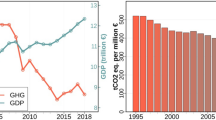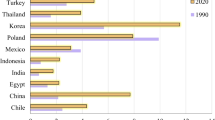Abstract
We present the main structure of the Greenhouse Gas Emission Model for Korea (GEMA-K), which is developed by IGES to cover the countries in Asia (Greenhouse Gas Eission Model for Asia: GEMA). We describe our estimation methods for the component equations of the energy demand module and the key parameters such as fuel substitution elasticities and technical change parameters entering the computable general equilibrium (CGE) module of GEMA-K.
We find that energy demand and CO2 emissions in Korea will continuously increase at a steady growth rate, as long as economic growth sustains. The energy demand and CO2 emissions in the transportation sector will increase rapidly for next two decades mainly due to the increase in income. Energy and CO2 emission profiles of the Korean industrial sector are mainly driven by its structurtal changes toward less energy-intensive industries for the next coming decades. For the residential and the commercial sectors, the increase in CO2 emissions is slower than that in energy demand, since fuel substitution to less carbon-intensive fuels is to occur in these sectors.
Similar content being viewed by others
References
Asia Pacific Energy Research Center (APERC), “Supplement to APERC Energy Supply Demand Outlook” (1998)
Blackorby, C. and R.R. Russell, “Will the Real Elasticity of Substitution Please Stand Up?,” The American Economic Review, 79 (1989) 882–888.
Christensen, L, D.W. Jorgenson and L.J. Lau, “Transcendental Logarithmic Utility Functions,” The American Economic Review, 65 (1975) 367–383.
Christensen L. and W. Greene, “Economies of Scale on U.S. Electric Power Generation,” Journal of Political Economy, 84 (1976) 655–676.
Christainsen G.B. and T.H. Tietenberg, “Distributional and Macroeconomic Aspects of Environmental Policy,” in V.K. Allen and L. Sweeney (ed)., Handbook of Natural Resource and Energy Economics, Volume 1, North-Holland (1985), 345–393.
Doornik, Jürgen A. and David E Hendry, “PcGive Student 8.0 An Interactive Econometric Modelling System,” London: International Thomson Publishing/Duxbury Press (1994).
Institute of Energy Economics, Japan (IEEJ) “Petroleum Substitution Energy - Econometric Analysis, for China and Korea” (1999) (in Japanese)
Ierland, E.C. van. “Macroeconomic Analysis of Environmental Policy,” Amsterdam: Elsevier (1993).
Johnston, Jack and John DiNardo, “Econometric Methods,” New York: The McGraw-Hall Companies, Inc. (1997).
Jung, T.Y. and Y.H. Soon, “Factor Demand and Economies of Scale for the Electric Industry in Korea” 16th Annual Conference of the International Association for Energy Economics, Bali, Indonesia (1993).
Jung, T.Y and C.G. Moon, “IGES Model for CDM Analysis: Model Structure and Initial Results for Japan”, 5th AIM International Workshop, Tsukuba, Japan (2000).
Manne, A.S. and T.F. Rutherford. “International Trade in Oil, Gas and Carbon Emission Rights: An Intertemporal General Equilibrium Model”. The Energy Journal, 15 (1994) 57–76.
Marini, G. and P. Scaramozzino, “Overlapping Generations and Environmental Control,” Journal of Environmental Economics and Management, 29 (1995) 64–77.
Author information
Authors and Affiliations
Rights and permissions
About this article
Cite this article
Jung, T.Y., Lee, H. & Moon, CG. A Greenhouse Gas Emission Model for Korea. OPSEARCH 38, 67–86 (2001). https://doi.org/10.1007/BF03398630
Published:
Issue Date:
DOI: https://doi.org/10.1007/BF03398630




